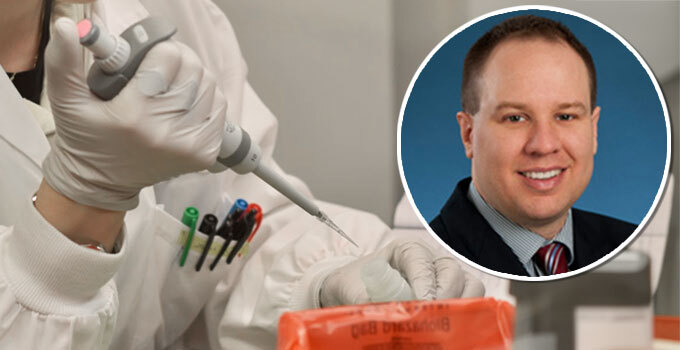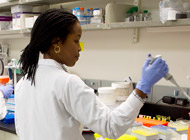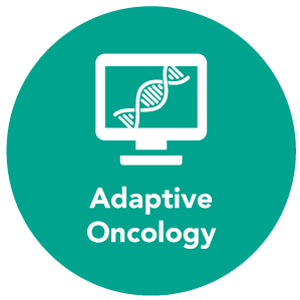The Ontario-wide Cancer Targeted Nucleic Acid Evaluation (OCTANE) expanded the province’s capacity for next-generation sequencing to deliver personalized approaches to treat cancer
Maddi was just 33 years old when she learned that her breast cancer had metastasized.
She was told the standard-of-care treatment for metastatic breast cancer at the time in 2019 could help manage her symptoms and slow her cancer’s progression, but ultimately her disease was considered terminal.
“I was really in shock,” recalls Maddi, who had already undergone chemotherapy and surgery. “I hadn’t fully understood that my breast cancer could spread like that.”
With the encouragement of a family member, she talked to her Medical Oncologist at the Princess Margaret Cancer Centre (University Health Network), Dr. Philippe Bedard, about options for genomic testing. Sequencing the genome of a tumour is a powerful way to identify ‘biomarkers’, which are molecular clues about the best way to treat a particular tumour.
At the time, Bedard was co-leading the groundbreaking Ontario-wide Cancer Targeted Nucleic Acid Evaluation (OCTANE) clinical trial. Funded by OICR and Princess Margaret and co-led by Bedard’s colleague Dr. Lillian Siu, OCTANE aimed to bring these powerful genomic tests to Ontarians with cancer.
Through OCTANE, Maddi found out her cancer had a particular genetic mutation, and there was another clinical trial testing a therapy that targeted cancers with that exact mutation. This kind of targeted approach to treating cancer is often called ‘personalized medicine’.
She started taking this targeted drug alongside standard-of-care medicines in the summer of 2019 and her tumours responded almost immediately. Today, she has no signs of disease progression, and lives a mostly normal life.
“I’m so grateful I had access to this opportunity,” says Maddi. “It has been life-changing, life-preserving and life-enhancing for me.”
The road to personalized medicine revolution
When Bedard started as a Medical Oncologist about 15 years ago, personalized medicine for cancer was just in its infancy.
There were few known molecular biomarkers, and few drugs to target them.
The technology to sequence tumour genomes was often expensive and cumbersome, and integrating it into clinical care seemed daunting.
“I think back to patients from that time, and I wish they could have benefitted from more personalized, targeted approaches to treating their cancer,” says Bedard.
A decade-and-a-half later, genome sequencing and personalized approaches to cancer care are becoming much more commonplace, and Ontario has positioned itself at the centre of a global revolution in personalized oncology.
While faster, cheaper sequencing technologies are a big reason for the shift, it was also fuelled by OCTANE.
The trial has connected more than 4,338 Ontarians across seven different cancer centres with next-generation sequencing (NGS), leading many participants like Maddi to receive treatments tailored to their tumour’s unique biology.
And while there is still plenty of work ahead to fully realize this revolution, the network OCTANE has built and the wealth of evidence it generated are bringing the future of personalized oncology within reach.
Collaborating to build Ontario capacity
OCTANE was launched in 2016 with a mission to expand NGS testing for advanced solid tumours in Ontario, in the hopes it could connect patients with personalized treatment approaches.
At the time, many Ontario hospitals didn’t have much experience with genomic testing. So Bedard and colleagues worked with clinicians and labs at cancer centres in Toronto, Kingston, London, Hamilton and Ottawa to build out local capacity.
“Before OCTANE, this kind of testing wasn’t feasible in some labs,” Bedard says. “Now, many of them are doing it routinely.”
The trial’s other main goal was to collect patient samples and make the data available to researchers looking to study potential biomarkers and treatments. The more than 3,000 tumour samples and 4,300 blood samples collected by OCTANE have been harnessed for all sorts of new discoveries, including OICR’s groundbreaking new test to find traces of cancer in blood.
OCTANE’s success has largely been driven by its diverse team of experts – including more than three dozen investigators – and its Ontario-wide approach. As the province’s cancer research institute, OICR has helped OCTANE make links between clinicians and researchers across Ontario and provided key infrastructure for the trial. OICR’s Genomics lab has performed much of the genomic sequencing for the study, while OICR Diagnostic Development’s Tissue Portal hosts the study’s samples.
“It’s unique that we can have different cancer centres working together, with support from OICR, to do these types of studies,” Bedard says. “You won’t see that kind of collaboration happen everywhere else.”
Lessons from a unique evaluation
While OCTANE’s primary focus was building capacity for NGS and testing its feasibility in cancer care, the study’s design also allowed for a unique evaluation of how NGS impacted patient outcomes and the health system at large.
Consenting OCTANE participants provided their Ontario health card number so their health outcomes could be followed through healthcare administrative data.
“This was a great success because we were able to answer the questions we wanted for a much lower cost than if we had to collect all of this information directly from thousands of patients over the course of many years,” says Dr. Timothy Hanna, a Clinician Scientist with OICR and the Division of Cancer Care and Epidemiology at Queen’s University
Their analysis was recently published in the Lancet journal EClinicalMedicine. It showed that cancer patients who had NGS through OCTANE were more than twice as likely to enroll in a clinical trial. Though NGS caused healthcare spending per-patient to rise, publicly funded drug costs decreased.
Perhaps their most significant finding was that NGS was not associated with an increase in overall survival in OCTANE participants. People with some cancer types – including ovary and biliary tract – survived longer after having genomic testing, but this difference was not seen in other cancers such as colon and breast cancer.
While this was not the result OCTANE researchers were hoping for, the findings point to several explanations and lessons to take forward. For example, only about four per cent of OCTANE participants received a targeted therapy, despite 54 per cent being found to have at least one actionable biomarker.
Hanna says this can partly be explained by the lack of a defined ‘pathway’ to connect cancer patients with personalized medicine clinical trials. It often falls on researchers and patients to parse through all available trial options and their unique eligibility criteria and compare that against patients’ health history and genomic profile. And this was even more challenging five years ago when OCTANE patients were recruited.
Thankfully this is a problem OCTANE data is being harnessed to help overcome, as OICR and Princess Margaret researchers work to develop machine learning software that links patients with cancer clinical trials.
Doubling down on personalized oncology research
Bedard says OCTANE results also reinforce the need to double down on genomic research to identify more biomarkers and understand how they can be used to guide treatment. With the recent launch of OCTANE 2.0, Bedard and Princess Margaret’s Dr. Benjamin Haibe-Kains are doing just that.
OCTANE 2.0 will build upon the network established in the first trial and focus more on treatment response and resistance. Bedard, Haibe-Kains and colleagues will use NGS to monitor how patients respond to certain drugs and identify people who have a high risk of relapse so they can be treated with a different approach.
The trial will put an extra emphasis on sequencing blood samples, looking for tiny fragments of tumour DNA that can give clues on the progress of a patient’s disease.
Bedard says he hopes OCTANE 2.0 will help generate new tools and therapies, and further strengthen Ontario’s capacity for personalized medicine.
“The technology is moving fast, and the network we’ve built in Ontario is making great progress,” says Bedard. “I’m enthusiastic this will translate into significant benefits for patients, helping them live longer, live better, and potentially be cured of cancer.”
Looking at a brighter future
Maddi hesitates when talking about approaching the all-important five-year mark since starting her combination of therapies. She’s just grateful to be living well and feeling well, aside from some manageable side effects from her medications.
It’s dramatically different from where she expected to be when she was first diagnosed with metastatic disease.
“This research has granted me five years of essentially stable health,” she says. “I want it to be available to more people, and I want them to know there’s hope.”
Maddi’s full name has not been used in order to protect her privacy.






